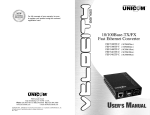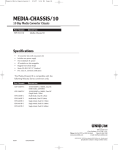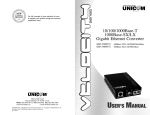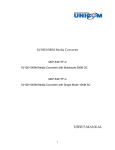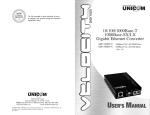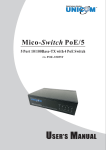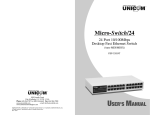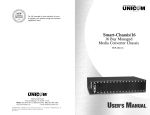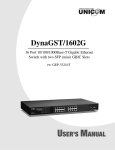Download UNICOM FEP-72107T Specifications
Transcript
For full coverage of your warranty, be sure to register your product using the enclosed registration card. 10/100Base-TX/100Base-FX Fast Ethernet Converter FEP-5300TF-C FEP-5300TF-T FEP-5300TF-M FEP-5400TF-C FEP-5401TF-C FEP-5402TF-C 908 Canada Court City of Industry, CA 91748 U.S.A. Phone: 626.964.7873 or 800.346.6668 Fax: 626.964.7880 www.unicomlink.com e-mail: [email protected] ©UNICOM 2004. UNICOM and “A Network Systems Solution” are trademarks of UNICOM Electric, Inc. All rights reserved. Specifications subject to change without notice. Rev: 02.04 ( SC/Multi-Mode/2km ) ( ST/Multi-Mode/2km ) ( MT-RJ/Multi-Mode/2km ) ( SC/Single Mode/15km ) ( SC/Single Mode/30km ) ( SC/Single Mode/60km ) USER’S MANUAL Package Contents Package contents include the following: ■ 10/100Base-TX to 100Base-FX Converter (Multi-Mode or Single Mode) ■ DC Power Adapter ■ User’s Manual ■ Rack Mount Brackets ■ Warranty card (not shown) 10/100Base-TX/FX User’s Manual Converter (Multi-Mode or Single Mode) Power Adapter Rack Mount Brackets Figure 1. Contents of package. IMPORTANT: If any piece is missing or damaged, please contact your local dealer or reseller for service. For Your Records Product Name: Serial Number: Date of Purchase: Purchased from: Notes: 1 Introduction Congratulations on purchasing a quality UNICOM product. Unicom’s VELOCITY Series represents the newest, most advanced generation of signal conversion technology. This converter is designed to expand your network through a fiber optic connection extending a fiber link up to 60 km (Single mode in full duplex mode). The 10/100TX/100FX Converters offer the most popular fiber cabling connectors: MT-RJ, SC, and ST formats in Multi-mode and SC in Single Mode. The UTP port supports the Auto MDI/MDIX function and there are 4 DIP switches to set the operation mode for the UTP ports, Fiber ports, the Link Loss Forwarding function, and the converter mode. These converters can be used in Unicom’s 10 bay VELOCITY Media Chassis or as stand-alone components. Key Features ■ Complies with IEEE 802.3, 802.3u, and 802.3x standards. ■ Converts between UTP cabling and Fiber Optic cabling. ■ One RJ-45 connector, Auto-MDI/MDIX for UTP port. ■ Supports 10/100 Mbps Auto-negotiation for UTP port. ■ Fiber cabling connectivity up to 60Km. ■ Uses store-and-forward switching to separate collision domains. ■ One fiber connector (SC/Single Mode or MT-RJ, SC, and ST/MultiMode) for 100Base-FX. ■ Prevents packet loss by supporting back-pressure & flow control. ■ Four DIP-switches for operation mode setup and Link-Loss Forwarding function. ■ Per port LEDs for diagnosis and maintenance ■ External DC power adapter, 9V DC/700mA ■ Can be mounted in chassis or used as stand-alone. ■ FCC Class A, CE Mark certification 2 Work Stations Hardware Description The Front Panel 1 2 3 4 4 FEP-5300TF-C 2km off on 1 2 3 4 3 2 1 off on DIP Setting UTP2 UTP Fast Ethernet Switch The Front Panel of the 10/100TX/100FX converters consists of one RJ-45 Port ( Auto MDI/MDIX ), 6 LED Indicators (TX SPD, LK/ACT, FDX/COL, Fiber LK/ACT, FDX and PWR ) and one fiber 100Base-FX Port. Fiber Fiber FEP-5300TF-M 2km 1 2 3 4 2km 4 FEP-5300TF-T 4 1 - 10/100TX Auto Negotiation 2 - 100FX Full Duplex 3 - LLF Enabled 4 - Switch Mode 2 1 3 FEP-5400TF-C FEP-5401TF-C FEP-5402TF-C UTP UTP 1 off on 2 1 3 1 2 3 4 off on DIP Setting 15km 30km 60km Ports Fast Ethernet Switch • RJ-45 Port (Auto MDI/MDIX): the Ethernet RJ-45 features AutoSensing for 10Base-T or 100Base-TX connections and Auto MDI/MDIX which is basically an auto crossover feature. This means you can connect to another Switch or workstation without changing to a crossover cable. • Fiber Port: This port is for the 100Base-FX connection. Unicom provides three different styles of fiber connectors (MT-RJ/SC/ST, Multi-Mode or SC, Single-mode). Back Bone Configuration Example Loss Link Forwarding DIP Explanation 1 2 3 4 10 3 Product Specifications LED Indicators There are six diagnostic LEDs located on the Front panel of these Converters. The LEDs provide real-time information on system status. The indicators include Power, UTP 100, LK/ACT, FDX/COL, Fiber LK/ACT, and FDX/COL. The following table provides descriptions of the LEDs. LED Status Color Description PWR On Green • The converter is supplied with suitable power. 100 On Green • Current UTP Speed LK/ACT On Blinking Off Green - • Unit is connected with a link • Unit is transmitting data • No device attached On Blinking Off Green - • Unit is connected with a link • Unit is transmitting data • No device attached On Blinking Orange - Off - • The UTP port is in full-duplex mode. • Packet Collisions occurring in port in Half-duplex mode. • Half-duplex mode/no device attached On Blinking Orange - Off - ( UTP ) LK/ACT ( Fiber ) FDX/COL ( UTP ) FDX/COL ( Fiber ) • The fiber port is in full-duplex mode. • Packet Collisions occurring in port in Half-duplex mode. • Half-duplex mode/no device attached Standard Compliance: IEEE 802.3 10Base-T/100Base-TX IEEE 802.3 100Base-FX Interface: (1) 10/100Base-TX Shielded RJ-45 Jack (1) 100Base-FX Dual SC, ST, or MT-RJ connector Wavelength: 1310nm. Link Distance: 10/100Base-TX, Category 5e/6, UTP/ScTP: 100m Max. 100Base-FX (MM), FEP-5300TF-C, M, and T: 2km Max. 100Base-FX (SM): FEP-5400TF-C, 15km Max. FEP-5401TF-C, 30km Max. FEP-5402TF-C, 60km Max. DIP Switches: Auto Negotiation, Fiber Duplexing, Loss Link Forwarding, and Converter Mode LED Indicators: Power, Link/Activity, Receive/Full-Duplex, 100 Power Supply: External power adapter 9V DC/700mA Operating Temperature: 0˚C to 55˚C Operating Humidity: 10% - 80% RH EMI: FCC Class A, CE Mark Enclosure: Metal Dimensions: 4.72"(L) x 3.36"(W) x .96"(H) 118mm x 84mm x 24mm Warranty: Limited Lifetime FCC Statement This equipment has been tested and found to comply with the limits for a class B device, pursuant to part 15 of the FCC rules. These limits are designed to provide reasonable protection against harmful interference in a commercial installation. This equipment generates, uses and can radiate radio frequency energy and, if not installed and used in accordance with instructions, may cause harmful interference with radio communications. Operation of this equipment in a residential area is likely to cause harmful interference, in which case, the user will be required to correct the interference at the user’s expense. 4 9 Troubleshooting DIP Switch • Verify that you are using the right power adapter ( DC 9V, 700mA ). Using a power adapter with DC output greater than 9V could result in damage to the unit and/or personal injury. The DIP-switches are used to configure operation mode for LLF ( Link Loss Forwarding ) and operation modes for the UTP/Fiber ports. • Check the configuration DIP switch. It must be set in the same operation mode as its link partner. • Confirm the proper UTP/Fiber cable is being used. The Single Mode converter must use Single Mode fiber optic cable. Optical Fiber Spec DIP-switch setup is as follows: No. Status 1 OFF ON UTP Port Auto Negotiation Enable UTP Port - 100M Full Duplex 2 OFF ON Fiber Port - 100M Full Duplex Fiber Port - 100M Half Duplex 3 OFF ON LLF Function Disable LLF Function Enable 4 OFF ON 10/100Base-TX (use between Switches) 100Base-TX only (use for workstations) The following table shows the optical fiber specification: Module Name Wavelength ( nm ) Avg. Launch Power ( dB ) Avg. Sensitivity ( dB ) FEP-5300TF-C 1310 nm -19 dB -31 dB FEP-5300TF-M 1310 nm -19 dB -31 dB FEP-5300TF-T 1310 nm -19 dB -31 dB FEP-5400TF-C (15km) 1310 nm -20 dB -31 dB FEP-5401TF-C (30km) 1310 nm -15 dB -34 dB FEP-5402TF-C (60km) 1310 nm -5 dB -34 dB Module Name Avg. Power Loss Budget (dBm) Max. FDX Fiber Distance (Km) Fiber Size (µm) FEP-5300TF-C 12 dBm 2 Km 62.5/125 50/125 FEP-5300TF-M 12 dBm 2 Km 62.5/125 50/125 FEP-5300TF-T 12 dBm 2 Km 62.5/125 50/125 FEP-5400TF-C 11 dBm 15 Km 9/125, 8/125 FEP-5401TF-C 19 dBm 30 Km 9/125, 8/125 FEP-5402TF-C 29 dBm 60 Km 9/125, 8/125 8 Description Note: To activate DIP switch 4, DIP 3 must be enabled. Link Loss Forwarding: The Link Loss Forwarding feature sends fiber or UTP link failure information to the switches. Any failure along the signal link is passed to and can be seen by an attached device. This feature is used for easy network diagnosis and supports switches utilizing Spanning Tree Protocol. Note: Do not change the DIP-switch setting while the UTP or fiber ports are transmitting or receiving data as data error may occur. Refer to page 10 for application diagram. Rear Panel The rear panel contains a power socket. This power socket accepts DC 9V voltage and minimum 700mA supplied current. DC IN 5 Network Connection C. Use a screwdriver to attach the rack mount ears to both sides of the modular converter. A. Select the appropriate length Category 5e or 6 twisted pair cable. Connect one end of the twisted pair cable to the RJ-45 connector on the converter and the other end of twisted pair cable to the RJ45 connector on any 10/100Base-TX device. D. Install the modular converter by inserting it into the chassis guides and sliding it in until it stops. Press it firmly to seat the chassis power plug into the modular converter receptacle. B. Connect one end of a fiber jumper to the fiber connector on this converter and the other end of the fiber jumper to the fiber connector on the other 100Base-FX device. Fiber 100Base-FX 1 2 3 4 1 2 3 4 UTP 10/100Base-TX UTP 10/100Base-TX 10/100Base-TX Port ( RJ-45 connector ) on switch/workstation 10/100Base-TX Port ( RJ-45 connector ) on switch/workstation C. Attach the power adapter DC jack to the converter. Verify that the Power LED is on. D. Verify that the UTP “LK/ACT” LEDs light when cable connection is installed correctly. Verify that Fiber “LK/ACT” LED blinks to indicate network activity. Installing Converters into Chassis Follow the steps below to install modular converters into the 10 space Velocity Converter Chassis (pn: FEP-593110). A. Remove the blank bracket from the chassis by rotating thumbscrew counterclockwise. Put the blank bracket aside. B. Open the rack mount bracket kit. The kit contains two rack mount brackets and four screws. 6 E. Gently push the thumbscrews in and turn clockwise to tighten. Do not over tighten. Cabling • Twisted-pair segments can be Unshielded Twisted Pair (UTP) or Shielded Twisted Pair (STP) cabling. The cable must comply with the IEEE 802.3u 100Base-TX standard for Category 5e. The cable between the conver ter and the link par tner (switch, hub, workstation, etc.) must be 100 meters (328 ft.) or less in length. • Fiber segments using Single Mode connectors must use 8/125 or 9/125 µm Single Mode fiber cable. The maximum link distance is 15, 30, or 60 Kilometers (depending on model) in full duplex operation. For half-duplex operation, the recommended maximum distance is 412 meters (1352 ft.). • Fiber segments using Multi-Mode connectors must use 50 or 62.5/125 µm Multi-Mode fiber cable. The maximum link distance is 2 Kilometers (6562 ft.). 7








